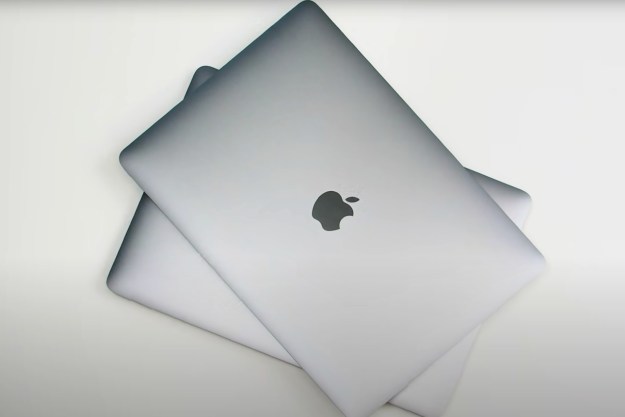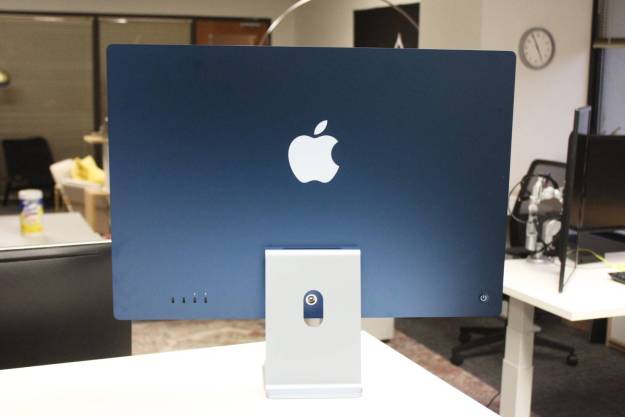
“The M3 makes the iMac even more powerful and dominant as an all-in-one.”
- M3 brings exponential GPU performance
- Great, thin design
- Full-bodied speakers
- Excellent webcam
- Bright, colorful display
- Limited ports
- Touch ID costs extra
There’s a new iMac. It’s not the one everyone’s been waiting for — the one with a larger screen and an M3 Pro.
But what we do have is an updated iMac that provides a significant uplift in performance over the M1 iMac, especially on the GPU front. There’s not much new here aside from the M3, but the original model did a lot of things right. This might not be the iMac you’ve been wanting, but it might be the one you need right now.
Design

The iMac’s design felt stark when it launched in 2021, and it’s no less remarkable today. Everything from the seven vivid colors and white bezels to the extremely thin profile makes this a stand-out in the Mac lineup. It’s a bold look. Now, I’m not saying everyone’s going to love the design – it remains a controversial aesthetic, that’s for sure. Not to mention the bright orange or pink options aren’t for everyone either.
On the other hand, I got the blue color for review, and as far as I’m concerned, it looks great. The pastel color on the front chin and corresponding colored stand base are particularly pleasing, especially when paired with the color-matched accessories and cables. The braided, magnetic power cable is the cherry on top.
In terms of adjustments, you’re limited to just the tilt up or down. This is a common problem with all-in-ones, including newer options like the Lenovo Yoga 9 AIO, which stuff the guts of the computer in the base. You’d think the iMac could get around this problem since the entirety of the computer is in the bottom chin, but alas, Apple has always been notorious for charging extra for its upgraded Mac stands (looking at you, Studio Display). Fortunately, because it weighs less than 10 pounds, turning the whole machine left or right is a breeze, so long as it’s on a smooth desk surface.
Peripherals

As new as the iMac design currently feels, the same can’t be said about the corresponding Mac peripherals. The base-level iMac ships with just a Magic Mouse and the non-Touch ID Magic Keyboard. You’ll need to pay an extra $50 each to upgrade to more serviceable and modern peripherals.
This is a problem for a number of reasons. First, the Magic Mouse itself is atrocious, and we all know this. It’s become the biggest inside joke among Mac users – specifically the fact that it can’t be used while charging. It’s been over eight years since the Magic Mouse 2 came out, and it’s long overdue for a refresh.
Then, there’s the keyboard. Again, the base model doesn’t come with Touch ID. Since Face ID still hasn’t come to the Mac, that means you’re stuck with antiquated passwords as your means of security. In 2024, it’s a little outrageous that Apple charges extra for basic security and more usable tracking devices.
That being said, typing on the Magic Keyboard feels great. The keyboard’s base is made of metal, which is more than can be said for most bundles-in peripherals.
Ports
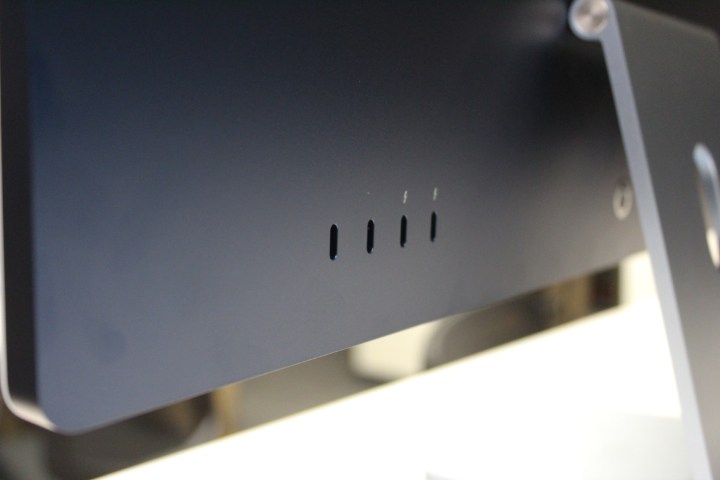
Like the peripherals, Apple makes you pay extra to have a decent number of ports. The base configuration comes with only two
My review unit came with the two additional USB-C ports, which gives enough for most people to work with — so long as you’re okay with using a
It also comes with the built-in Gigabit Ethernet jack on the power block. It’s a really convenient and organized way to get a hardwire connection. The only problem, again, is that Apple nickels and dimes you to add it to the base model. I get that not everyone would even use this, but with ports, you’re better safe than sorry.
Display
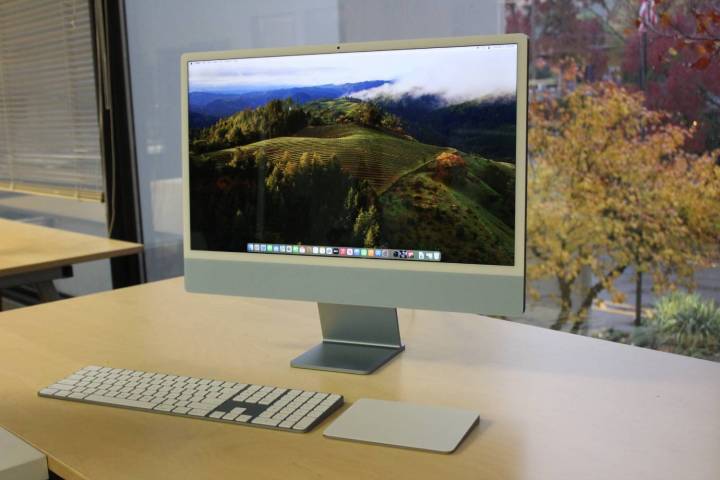
Nothing about the display itself has changed on the M3 version of the iMac. It’s still impressive and bright, measuring up to 518 nits of brightness. The 4.5K panel measures 4480 x 2520 matching the sharpness of the Studio Display identically at 218 ppi (pixels per inch), despite being a few inches smaller diagonally. It’s every bit as color-dense and accurate too. Considering the iMac as a whole starts at $300 less than the Studio Display, it’s a pretty killer value. But at this point, I think that says more about the Studio Display than it does about the iMac.
However, the size of the iMac’s screen does continue to be one of the sticking points for people considering the purchase. Apple says the size of 24 inches diagonally was meant to please people upgrading from both the old 21.5-inch and the 27-inch iMacs. A happy medium, so to speak. For most people, Apple’s right. It’s big enough. There’s plenty of screen real estate for multitasking and Split View mode, and unless you’re coming from a MacBook Pro with its XDR screen, you won’t be complaining about quality.
It’s easily my favorite webcam of any Mac.
But for me, it still definitely leaves space for a larger iMac Pro to slide into the picture at some point, with an XDR Liquid Retina screen that’s both sharper and brighter than the 24-inch iMac. Throw in the ProMotion refresh rate for good measure too, especially since 120Hz non-gaming monitors are starting to flood the market for under $500.
I mention all that because it does seem probable that Apple will eventually address that market. We just don’t know when. Apple’s marketing team is talking like it may not happen within this generation, but we just don’t know, which puts buyers with a need for a higher-end product in a bit of a bind. At this point, it’s safer to go with a Mac Studio or MacBook Pro.
Audio and video
I should mention the webcam, which is located in the top bezel of the display. It’s 1080p, and it’s fantastic. It’s easily my favorite webcam of any Mac, including the 12-megapixel camera built into the Studio Display. Sorry, but the iMac really does provide a clearer, more balanced image that is perfect for video calls. Even in less-than-ideal lighting, the iMac manages to produce a usable image that’s surprisingly detailed.
The other important aspect of the audio/video setup is the speakers. This is the same six-speaker setup with force-cancelling woofers that we’ve seen on the Studio Display and MacBook Pro — and although it’s not new with the M3 model, it’s worth mentioning again just how fantastic they sound. You’ll get more bass out of a set of traditional PC speakers that include a dedicated subwoofer, but for what it is, they sound terrific. Crisp and balanced, with a wide sound stage and plenty loud. If you have this iMac out in your living room, you’ll have no problem filling it with sound.
Performance
Moving from the M1 to the M3 is a big jump. Even if you think the performance changes between each individual generation aren’t too exciting, skipping one adds up to a noticeable difference.
When you look at Cinebench R23 scores, the M3 is a whopping 20% faster in both single-core and multi-core. That’s massive. It means no matter what the strenuous task is, the M3 iMac will be at least 20% faster. A good example is a simple video encoding test in Handbrake. The M3 iMac encoded the same video to H.265 27% faster than the M1 iMac.
The M3 iMac even beats the M2 Pro Mac mini in graphics.
It shows how far Apple has taken these chips in just a few generations, especially on the GPU front. I was sent the 10-core GPU model, and with the inclusion of Dynamic Caching, this little iMac is a pretty solid little engine for graphics. In the Cinebench 2024 GPU test, it was 35% faster than the M1 Pro in a 14-inch MacBook Pro despite having six less GPU cores. Meanwhile, the M3 iMac beats the M2 Pro in the Mac mini by 20% in this same graphics test. Again, I think you can credit Dynamic Caching for doing a lot of the heavy lifting in that comparison.
Another interesting comparison to make, however, is against the Lenovo Yoga 9 AIO. This recently released all-in-one desktop uses the latest Intel Core i9-13900H, and fares significantly better in terms of multi-core performance. It should be noted that when configured similarly, the iMac M3 is around $300 more expensive. The only problem? The Yoga 9 AIO isn’t currently sold with a discrete GPU, which means it’d be significantly behind in terms of graphics performance.
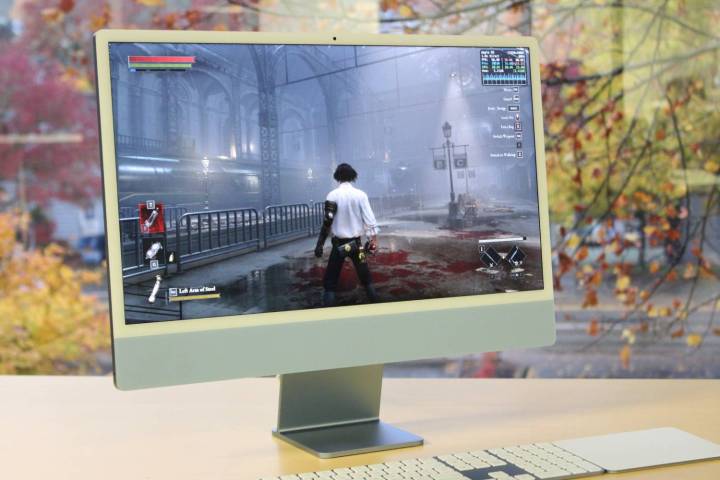
Speaking of gaming, I was able to test out the Lies of P. This is a well-optimized AAA game, but exactly the kind of thing base configuration Macs weren’t able to play smoothly before. On the M3, I was impressed to see that you can squeeze a somewhat enjoyable experience out of this iMac. You’ll need to drop some settings, of course — even at 1080p. The setting I found the most enjoyable was the Medium graphics setting with MetalFX Upscaling turned to the “Quality” mode. The visual deficit wasn’t too bad, and the frame rate was still hovering right around 55 fps (frames per second). Sticking with the Low setting was also fairly satisfactory, even if you lose a good amount of the textural details. Of course, the screen is locked at 60Hz anyway.
If you want, you can certainly try it at the Best graphics settings, but without using the “Performance” modes in MetalFX Upscaling, you’ll be stuck around 30 fps. These higher settings look awful, though, so I wouldn’t bother. So no, the iMac is not at all meant for serious gaming. But the fact that you can play a game like Lies of P at all is a huge testament to what Apple has done with the graphics in the M3.
It’s certainly more than you can expect out of Windows
Configurations
If you do intend to buy an M3 iMac, there are a few things you should know. Despite how it’s sold on Apple’s website, there are really only two versions of this iMac.
The $1,299 base model doesn’t come with the two extra USB-C ports, the Gigabit Ethernet jack, and two GPU cores. The only other difference is that it’s limited to just a terabyte of storage, whereas the $1,499 model lets you configure up to two terabytes.
To upgrade or not?
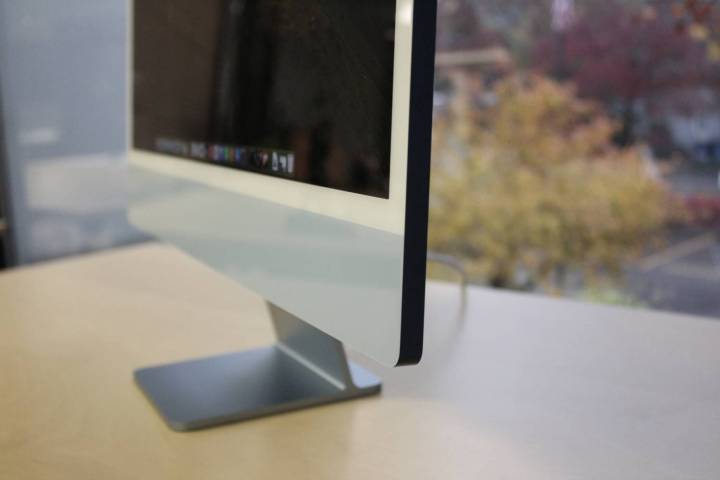
The question for many, I assume, will be if it’s worth upgrading over your old Intel-based iMac, which is at least four years old at this point (and possibly much, much older). Those iMacs were already the most powerful all-in-ones you could buy at the time, making them a go-to option for creatives for many years. But by now, they’ve no doubt grown long in the tooth in more ways than one, and Apple is determined to sell the M3 iMac as the obvious upgrade.
And I think for many people, it is. You might miss the size of the 27-inch screen, but the benefits of being Apple Silicon, especially the M3, vastly outweigh what you’d be giving up. And given how fast the M3 is, there are fewer reasons to wait for an iMac Pro – if indeed one is actually in the works. It’s definitely a safe upgrade coming from an older iMac, but if you’re coming from the M1 model, I don’t think there’s enough here to tempt you either.
And yet, there’s no question that the single iMac is not serving the entirety of the demographic. Both in terms of performance and premium quality, a larger and more powerful iMac still makes a lot of sense. If you really need more performance, you can always jump to the M2 Ultra Mac Studio, but the iMac form factor will always be appealing if Apple can make it work. That’s especially true given how good the M3 Max is performing in the MacBook Pro.
One can certainly hope, but for now, the iMac remains the best all-in-one you can buy, even if it’ll leave some waiting for something more premium.
Editors' Recommendations
- Best Apple deals: AirPods, Apple Watch, iPad, and MacBook
- The MacBook Pro M3 doesn’t have a memory problem — it has a pricing problem
- Apple just dashed our iMac hopes and dreams
- Apple M3: explaining the next generation of Apple silicon
- Apple’s new M3 Pro might come with an unexpected downgrade


